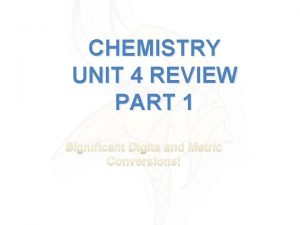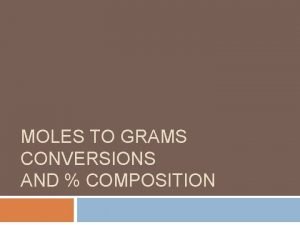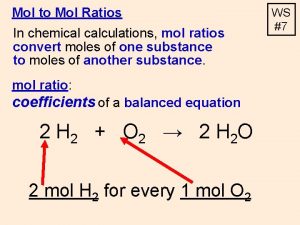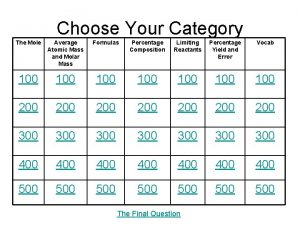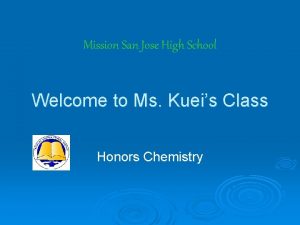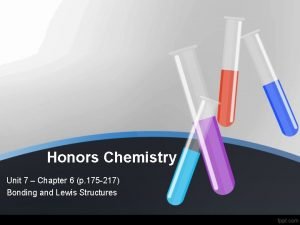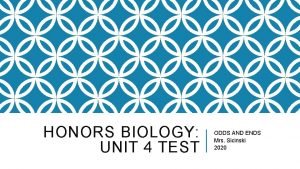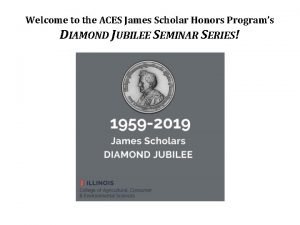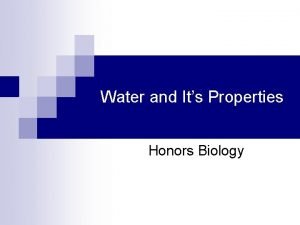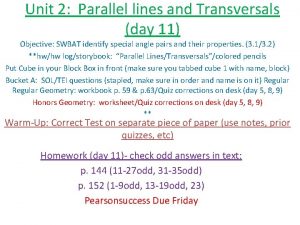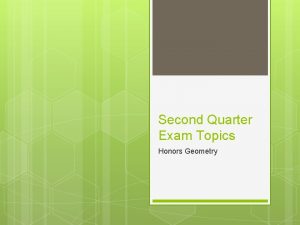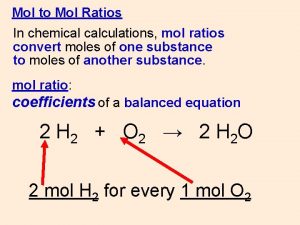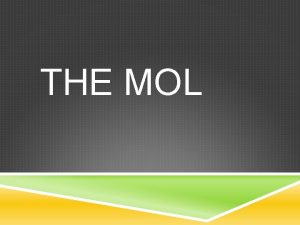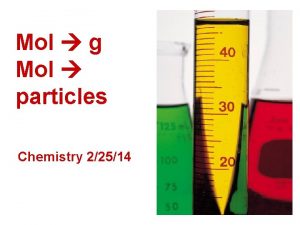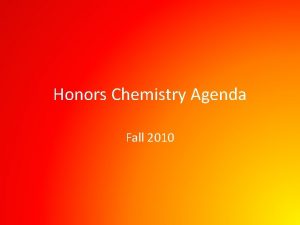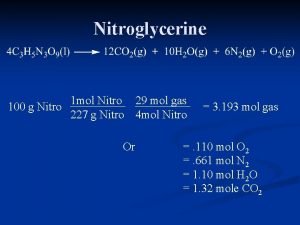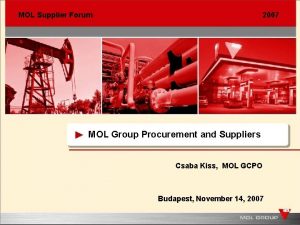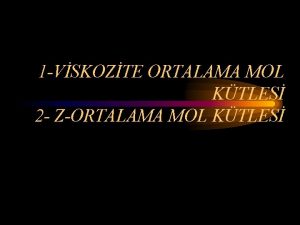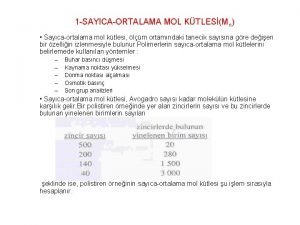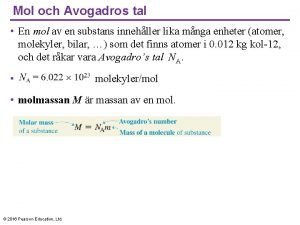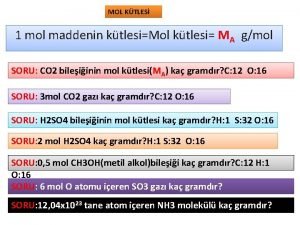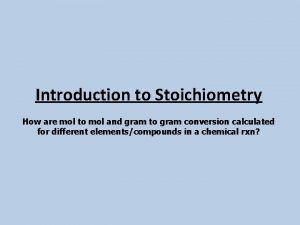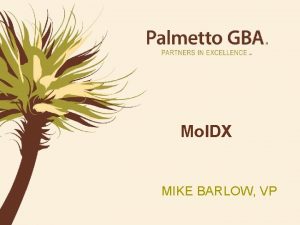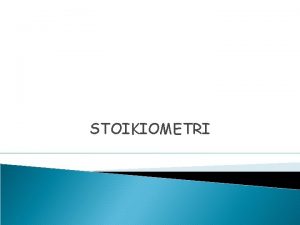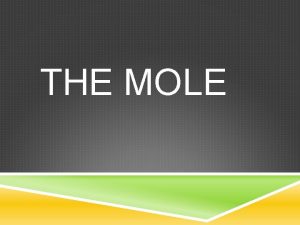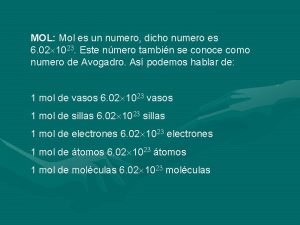m v p Honors MOL Chemistry Unit 6




























- Slides: 28

m v p Honors MOL Chemistry Unit 6: The Mathematics of Chemical Formulas SO 3 C a 2 N . O 3 1 H 0 O 2 Cu(OH)2

# of H 2 O molecules # of H atoms # of O atoms 1 2 4 2 3 6 3 100 200 100 6. 02 x 1023 2 (6. 02 x 1023) 6. 02 x 1023 18. 0 g 2. 0 g 16. 0 g molar mass: the mass of one mole of a substance

Pb. O 2 HNO 3 Pb: 1 (207. 2 g) = 207. 2 g O: 2 (16. 0 g) = 32. 0 g H: 1 (1. 0 g) N: 1 (14. 0 g) = 14. 0 g O: 3 (16. 0 g) = 48. 0 g ammonium phosphate (NH 4)3 PO 4 N: 239. 2 g = 1. 0 g 63. 0 g NH 4+ PO 43– 3 (14. 0 g) = 42. 0 g H: 12 (1. 0 g) = 12. 0 g P: 1 (31. 0 g) = 31. 0 g O: 4 (16. 0 g) = 64. 0 g 149. 0 g

percentage composition: the mass % of each element in a compound g element x 100 % of element = molar mass of compound Find % composition Pb. O 2 239. 2 g (NH 4)3 PO 4 149. 0 g (see calculation above) 207. 2 g Pb : 239. 2 g = 86. 6% Pb 32. 0 g O : 239. 2 g = 13. 4% O 42. 0 g N 12. 0 g H 31. 2 g P 64. 0 g O : 149. 0 g = = 28. 2% N 8. 1% H 20. 8% P 43. 0% O

zinc acetate Zn 2+ CH 3 COO– Zn(CH 3 COO)2 Zn: 1 (65. 4 g) = 65. 4 g = 35. 7% Zn C: 4 (12. 0 g) = 48. 0 g = 26. 2% C H: 6 (1. 0 g) = 6. 0 g O: 4 (16. 0 g) = 64. 0 g 183. 4 g : 183. 4 g = 3. 3% H = 34. 9% O

Mole Calculations Must Use Periodic Table! Mass (g) Volume (L or dm 3) 1 mol = molar mass (in g) 1 mol = 22. 4 L 1 mol = 22. 4 dm 3 Particle (at. or m’c) Remember…we use the conversions to set up ratios and cancel units MOLE (mol) 1 mol = 6. 02 x 1023 particles 1 mol 6. 02 x 1023 OR particles 6. 02 x 1023 particles 1 mol

1 mol = molar mass (in g) Mass (g) Volume (L or dm 3) New Points about Island Diagram: 1 mol = 22. 4 L MOLE (mol) 1 mol = 22. 4 dm 3 Particle (at. or m’c) 1 mol = 6. 02 x 1023 particles a. Diagram now has four islands b. “Mass Island” now for elements or compounds c. “Particle Island” now for atoms or molecules d. “Volume Island”: for gases only 1 mol @ STP = 22. 4 L = 22. 4 dm 3

1. What mass is 1. 29 mol iron (II) nitrate ? Fe 2+ NO 3– Fe(NO 3)2 1. 29 mol 179. 8 g 1 mol = 232 g 2. How many molecules is 415 L sulfur dioxide at STP? SO 2 415 L 1 mol 22. 4 L 6. 02 x 1023 m’c 1 mol = 1. 12 x 1025 m’c

3. What mass is 6. 29 x 1024 m’cules aluminum sulfate ? Al 3+ SO 42– Al 2(SO 4)3 1 mol 6. 29 x 1024 m’c 6. 02 x 1023 m’c 342. 3 g 1 mol = 3580 g 4. At STP, how many g is 87. 3 dm 3 of nitrogen gas? N 2 87. 3 L 1 mol 28. 0 g 22. 4 L 1 mol = 109 g

5. How many m’cules is 315 g of iron (III) hydroxide? OH– Fe 3+ Fe(OH)3 315 g 1 mol 106. 8 g 6. 02 x 1023 m’c 1 mol = 1. 78 x 1024 m’c 6. How many atoms are in 145 L of CH 3 CH 2 OH at STP? 1 mol 6. 02 x 1023 m’c 1 mol 22. 4 L = 3. 90 x 1024 m’c But there are 9 atoms per molecule, so… 145 L 9 (3. 90 x 1024) = 3. 51 x 1025 atoms

Finding an Empirical Formula from Experimental Data a. Find # of g of each element. “What’s your flavor of ice cream? ” b. Convert each g to mol. c. Divide each “# of mol” by the smallest “# of mol. ” d. Use ratio to find formula. 1. A compound is 45. 5% yttrium and 54. 5% chlorine. Find its empirical formula. YCl 3

2. A ruthenium/sulfur compound is 67. 7% Ru. Find its empirical formula. Ru. S 1. 5 Ru 2 S 3

3. A 17. 40 g sample of a technetium/oxygen compound contains 11. 07 g of Tc. Find the empirical formula. Tc. O 3. 5 Tc 2 O 7

4. A compound contains 4. 63 g lead, 1. 25 g nitrogen, and 2. 87 g oxygen. Name the compound. ? Pb. N 4 O 8 ? Pb(NO 2)4 Pb? 4 NO 2– lead (IV) nitrite (plumbic nitrite)

To find molecular formula… a. Find empirical formula. b. Find molar mass of empirical formula. c. Find n = mm molecular mm empirical d. Multiply all parts of empirical formula by n. (“What’s your flavor? ”) (“How many scoops? ”) (How many empiricals “fit into” the molecular? )

1. A carbon/hydrogen compound is 7. 7% H and has a molar mass of 78 g. Find its molecular formula. emp. form. CH mmemp = 13 g 78 g =6 13 g C 6 H 6

2. A compound has 26. 33 g nitrogen, 60. 20 g oxygen, and molar mass 92 g. Find molecular formula. NO 2 mmemp = 46 g 92 g =2 46 g N 2 O 4

Hydrates and Anhydrous Salts anhydrous salt: an ionic compound (i. e. , a salt) that attracts water molecules and forms loose chemical bonds with them; symbolized by MN “anhydrous” = “without water” Uses: “desiccants” in leather MN = metal + goods, electronics, vitamins nonmetal hydrate: an anhydrous salt with the water attached symbolized by MN. ? H 2 O Examples: Cu. SO 4. 5 H 2 O Na 2 CO 3. 10 H 2 O Ba. Cl 2. 2 H 2 O Fe. Cl 3. 6 H 2 O

H 2 O H 2 O MN H 2 O H 2 O hydrate HEAT MN H 2 O HO H 2 O H O 2 H 2 O 2 + anhydrous salt ENERGY water + +

Finding the Formula of a Hydrate 1. Find the # of g of MN and # of g of H 2 O 2. Convert g to mol 3. Divide each “# of mol” by the smallest “# of mol” 4. Use the ratio to find the hydrate’s formula

Find formula of hydrate for each problem H 2 O sample’s mass before heating = 4. 38 g MN. ? H 2 O (hydrate) sample’s mass after MN heating = 1. 93 g (anhydrous salt) molar mass of anhydrous salt = 85 g MN. 6 H 2 O

A. beaker = 46. 82 g MN H 2 O B. beaker + sample before heating = 54. 35 g C. beaker + sample after heating = 50. 39 g molar mass of anhydrous salt = 129. 9 g MN. 8 H 2 O beaker + salt + water beaker + salt

A. beaker = 47. 28 g MN H 2 O B. beaker + sample before heating = 53. 84 g C. beaker + sample after heating = 51. 48 g molar mass of anhydrous salt = 128 g MN. 4 H 2 O beaker + salt + water beaker + salt

For previous problem, find % water and % anhydrous salt (by mass). or…

Review Problems 1. Find % comp. of iron (III) chloride. Fe 3+ Cl– Fe. Cl 3 Fe: 1 (55. 8 g) = 55. 8 g Cl: 3 (35. 5 g) = 106. 5 g 162. 3 g : 162. 3 g 34. 4% Fe 65. 6% Cl

2. A compound contains 70. 35 g C and 14. 65 g H. Its molar mass is 58 g. Find its molecular formula. emp. form. C 2 H 5 mmemp = 29 g 58 g =2 29 g C 4 H 10

3. At STP, how many g is 548 L of chlorine gas? Cl 2 548 L ( 1 mol 22. 4 L )( 71. 0 g 1 mol )= 1740 g

4. Strontium chloride is an anhydrous salt on which the following data were collected. Find formula of hydrate. A. beaker = 65. 2 g B. beaker + sample before heating = 187. 9 g C. beaker + sample after heating = 138. 2 g Sr 2+ Cl 1– Sr. Cl 2 beaker + salt + water beaker + salt Sr. Cl 2. 6 H 2 O
 Honors chemistry unit 4 review answers
Honors chemistry unit 4 review answers Conversion from moles to grams
Conversion from moles to grams Mass to moles formula
Mass to moles formula How to calcuate moles
How to calcuate moles Unit of avogadro number
Unit of avogadro number What can be said about 1 mol ag and 1 mol au
What can be said about 1 mol ag and 1 mol au Kuei honors chemistry
Kuei honors chemistry Honors chemistry summer assignment
Honors chemistry summer assignment Honors chemistry
Honors chemistry Honors biology unit 4 test
Honors biology unit 4 test Golden opulence sundae
Golden opulence sundae Moles formula chemistry
Moles formula chemistry Creighton honors program
Creighton honors program James scholar program
James scholar program Policy guidelines on awards and recognition
Policy guidelines on awards and recognition Ucsb honors seminars
Ucsb honors seminars Honors physics semester 2 review
Honors physics semester 2 review Honors biology ecology test
Honors biology ecology test 4.05 economics honors
4.05 economics honors Honors geometry quadrilaterals test
Honors geometry quadrilaterals test Honors earth science
Honors earth science Honors math 3
Honors math 3 Hilton honors military program
Hilton honors military program Honors project
Honors project Honors biology properties of water lab
Honors biology properties of water lab Honors geometry parallel lines and transversals worksheet
Honors geometry parallel lines and transversals worksheet Tulane honors program
Tulane honors program Honors geometry chapter 3
Honors geometry chapter 3 Pre calculus chapter 1
Pre calculus chapter 1
